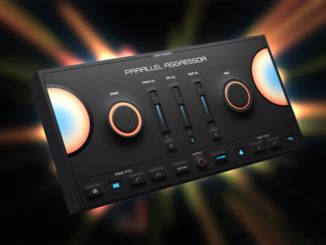Baby Audio Atoms is a new physical modeling Synthesizer plugin based on a novel mass-spring interaction network, now available.
Good news from Baby Audio. The mass-spring physical modeling Synthesizer Atoms is now available for iOS AUv3 on the Apple AppStore for $19,99.
Update From February 7, 2024
The new Baby Audio Synthesizer Plugin Atoms, announced at NAMM 2024, is now available. Atoms is a unique physical modeling Synthesizer plugin. Instead of the classic exciter resonator concept, it uses a unique mass-spring interaction network, a concept we already have in the Physical Audio Mode synth.
Even though, for many this is like music mathematics, BA has managed to incorporate this fascinating idea into a plugin in an attractive and hands-on way.
Besides the six hands-on parameters, Baby Audio added a powerful automation and randomization engine to create constantly evolving sounds. For example, the random engine selectively adjusts each parameter based on its relationship to the others.
What I already wrote during NAMM has now been confirmed. Atmos doesn’t have classic effects but a unique approach to it that that derived from the behavior of the physical model itself. That’s intriguing.
Lastly, the plugin ships with 250 presets from professional sound designers.
Article From January 28, 2024
Last April, Baby Audio released its first Synthesizer plugin, the BA-1. A modern take on the vintage Yamaha CS01 synthesizer. It’s a nice plugin with excellent sound and nice extras. This wasn’t the last synth plugin from BA.
At NAMM 2024, Baby Audio introduced Atoms, a new exciting physical modeling Synthesizer.
Baby Audio Atoms
Atoms is Baby Audio’s second Synthesizer plugin. It’s a physical modeling Synthesizer based on a unique mass/spring interaction network. More precisely, it models a network of masses connected by springs with inertia and weight, with sound generated by “playing” it with a virtual bow.
The concept reminds me of the Physical Audio Mode Synthesizer. It also combines masses and springs to create unique sounds.
Even if the underlying core of Atmos is very complex and technical, the user will see little of it. Baby Audio has made the whole thing very user-friendly with a limited set of parameters that significantly impact the sound.
You can craft your sounds using the parameters: force (how the bow plays the model), chaos, drive (saturation), order, overtones (the position on the model you apply the bow to change harmonics), and a lowpass filter.
On the effects side, it has a built-in chrous and vibrato. Interesting are points in the BA NAMM presentation: there is no delay/reverb and the onboard effects are not based on standalone algorithms. They are generated by the physical model engine itself. Cool idea.
According to Baby Audio, it will also host an internal modulation/automation system. This includes an X/Y pad, envelopes, and full MPE support great for evolving sounds. The latter allows you to assign MPE to the six parameters for very expressive sounds.
First Impression
I’m a big fan of physical modeling synthesizers. The announcement that Baby Audio’s next synth will explore physical modeling really piqued my interest. I’m excited to see how versatile it will be and whether it will bring a lot of new, unheard sounds.
Baby Audio Atoms is available now for an introductory price of $59 instead of $99 until March 30, 2024. It runs as a VST, VST3, AU and AAX plugin on macOS (native Apple Silicon + Intel) and Windows.
More information here: Baby Audio






Its like Chromaphone by AAS never existed…
It’s called “scanned synthesis” and it’s been around since the late 90s. Anyone who wants to check out what is can do can do it for free with Csound or Pure Data. The Wikipedia page for “scanned synthesis” has more information.
It’s fun, but unpredictable. In a nutshell: a system of masses and springs is modeled. You apply forces to those masses to make them oscillate at sub-audible rates, and then “scan” (thus the name) the system at audio rates to produce sound. Kind of like a wavetable synth when the wavetable is produced by physics instead of being a static thing.
Determining useful values for masses, spring tensions, and applied forces quickly becomes a massive juggling act. It is pretty cool that you can use it either as a sound source by “plucking” it and scanning what happens, or as an effects processor by “forcing” it with an audio input and scanning what happens. But again, so many parameters, it’s easier to make a huge mess than useful sounds.
Presumably these VSTs make it more accessible.
Also, Humanoid Sound Systems used to have a “Scanned Synth VST”, but they folded in 2018, so I have no idea how anyone would get a hold of that one anymore.
Uh yes the Humanoid Sound Systems plugins, I remember. Sad that they stopped because Scanned Synth VST was fun.
I have (or had) the Humanoid one, it was called Enzyme. It sounded absolutely brutal but the plugin was very crashy, got plenty of stuff bounced down from it though so that’s something.